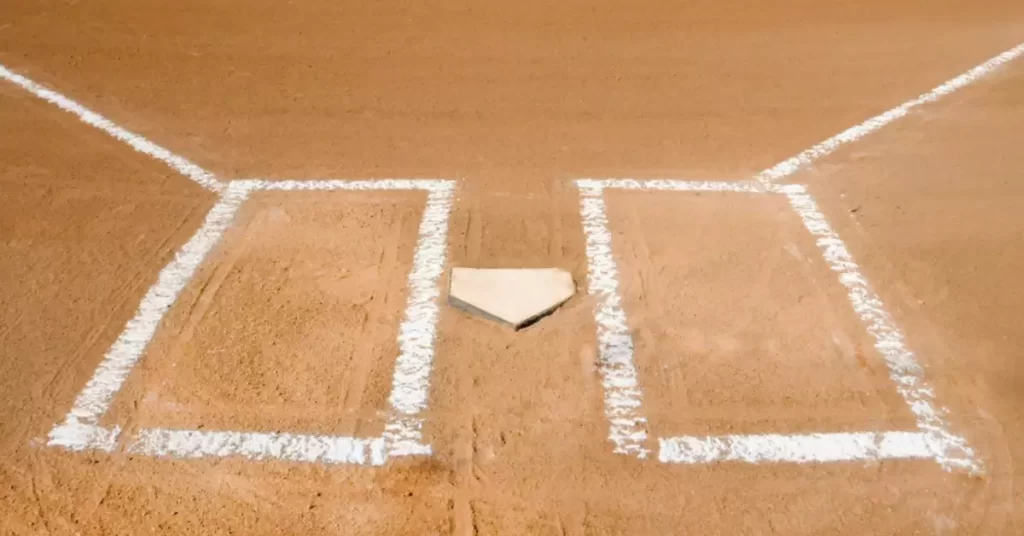The batter’s box is a crucial component in the game of baseball. It is the space where batters position themselves to face the pitcher’s throws. The location a batter chooses to stand can significantly impact their success at the plate.
Finding the ideal spot to stand within the batter’s box can greatly improve your batting performance. Various factors like pitch type, stance, and personal preferences come into play when determining the right position to enhance your chances of hitting the ball.
Ready to unlock the secrets of the batter’s box? Keep reading as we delve into the intricacies of this essential aspect of the game, helping you refine your batting strategy and achieve greater success.
Understanding the Batter’s Box
The batter’s box is a rectangular area beside home plate where the batter stands during their at-bat. It measures 6 feet by 4 feet and is divided into two sections, one for right-handed batters and one for left-handed batters.
Knowing where to position yourself within this confined space can significantly impact your hitting performance.
Finding Your Ideal Stance
Assessing Your Swing Type
To find your optimal stance in the batter’s box, start by understanding your swing type. Are you a power hitter who aims for home runs, or are you a contact hitter who focuses on making consistent contact with the ball?
Power hitters may benefit from standing closer to the plate, while contact hitters might find success standing further back, allowing more time to react to the pitch.
Factoring in Pitch Types
Different pitches require different adjustments in the batter’s box. For example, when facing a fastball, you’ll want to stand slightly closer to the pitcher to decrease the reaction time.
Conversely, when facing off-speed pitches like curveballs or sliders, standing further back allows you more time to identify and react to the pitch.

Strategic Positioning
Playing to Your Strengths
Identify the areas in the strike zone where you hit best, and position yourself accordingly. For instance, if you excel at hitting low and inside pitches, stand closer to the plate with your back foot parallel to the back edge of the batter’s box.
This positioning allows you to better cover the inside part of the plate and capitalize on your strengths.
Exploiting Pitcher Weaknesses
Scouting reports and your own observations can help you identify a pitcher’s weaknesses. If a pitcher struggles with their control, standing closer to the plate may force them to throw more strikes or risk hitting you with a pitch.
Adjustments Based on Pitcher and Game Situation
Situational awareness is key in baseball. Be ready to adjust your stance based on the current game situation, the pitcher you’re facing, and the pitch count.
For example, if you’re facing a pitcher who frequently throws breaking balls with two strikes, consider moving back in the box to give yourself more time to react.
Similarly, if you’re facing a pitcher known for their fastball, you might want to move closer to the plate to decrease the reaction time.
Common Positioning Mistakes
Avoid these common mistakes when positioning yourself in the batter’s box:
- Standing too close to the plate: This can lead to jammed pitches and a decreased ability to cover the outside part of the plate.
- Standing too far away from the plate: This can result in reaching for pitches and weak contact.
- Inconsistent positioning: Changing your stance between pitches or at-bats can disrupt your timing and make it difficult to find a rhythm.

The Importance of Practice
Developing a consistent stance and understanding where to stand in the batter’s box takes time and practice. Work on your positioning during batting practice and make adjustments based on your performance. Over time, you’ll become more comfortable and confident in the batter’s box.
The Role of Mental Preparation
Mental preparation is crucial for success in the batter’s box. Develop a pre-pitch routine that helps you clear your mind and focus on the task at hand. Visualize success, stay positive, and trust your instincts when it’s time to swing.
Analyzing Your Performance
Regularly review your at-bats to identify areas for improvement. Look for trends in your swing and stance, and make necessary adjustments.
Consider working with a hitting coach or using video analysis tools to gain deeper insights into your performance.
The Impact of Batting Order
Your position in the batting order can also influence your approach in the batter’s box. For example, leadoff hitters are typically expected to work the count and get on base, while cleanup hitters are tasked with driving in runs. Understand your role in the lineup and adjust your stance and approach accordingly.
Frequently Asked Questions
How do I determine the best position for my swing type?
Start by understanding your swing type (power or contact) and consider the types of pitches you face most frequently. Power hitters may benefit from standing closer to the plate, while contact hitters might find success standing further back.
How can I adjust my stance based on the pitcher’s tendencies?
Study scouting reports and observe the pitcher during the game. Look for patterns in their pitch selection and location. Use this information to position yourself strategically in the batter’s box to capitalize on their weaknesses.
How often should I adjust my stance in the batter’s box?
While it’s essential to be adaptable, avoid making constant adjustments. Instead, focus on developing a consistent stance and making minor tweaks based on your performance and the game situation.
Conclusion
As we’ve explored, the batter’s box is a strategic area that demands careful consideration. The perfect spot to stand is unique for each player and is influenced by factors such as pitch type, personal preferences, and batting style.
Don’t overlook the importance of understanding where to stand in the batter’s box. Invest time in refining your positioning, and witness the benefits in your game performance.
With knowledge and practice, you’ll elevate your batting skills and consistently make more powerful, accurate hits.
